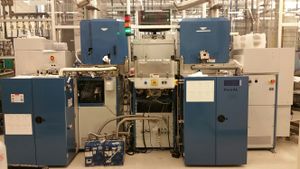CAIBE (Oxford Ion Mill): Difference between revisions
added cluster config section |
m added CAIBE acronym expansion to description, for google searchability |
||
| Line 13: | Line 13: | ||
==About== |
==About== |
||
This is an Oxford Instruments PlasmaLab 300 IBE/RIBE/CAIBE system used for ion beam etching of a variety of materials including metals, oxides, semiconductors. Ion beam etching allows control of sidewall etch profiles by tilting and rotating the sample during the etch. Reactive chemistry |
This is an Oxford Instruments PlasmaLab 300 IBE/RIBE/CAIBE system used for ion beam etching of a variety of materials including metals, oxides, semiconductors. Ion beam etching (IBE) allows control of sidewall etch profiles by tilting and rotating the sample during the etch. Reactive chemistry ("Chemically Assisted Ion Beam Etching", CAIBE) can be used, when appropriate, to enhance the etch rate of materials, such as oxides, polymers, and semiconductors. |
||
This system is used to ion beam etch noble and inert metals with Ar ion milling and to etch other materials that react with chlorine, fluorine, or oxygen using a reactive ion beam. The ion beam is generated in a 15cm diameter 3-grid ion source manufactured by Oxford. Ion beam voltage |
This system is used to physically ion beam etch noble and inert metals with Ar ion milling, and to etch other materials that react with chlorine, fluorine, or oxygen using a reactive ion beam. The ion beam is generated in a 15cm diameter 3-grid ion source manufactured by Oxford. The Ion beam voltage & current control the etch rate. Beam voltage (related to ion energy) affects the sputter yield (atoms etched per incident ion) and Ion beam current controls the flux of ions (number of ions in the beam). Etch rate should be roughly linear with beam current. Neutralizing electrons are generated by a plasma bridge neutralizer (PBN) so that samples are not charged by ions during the etch. Samples can be cooled to 5°C or heated to 300°C for etching. He back-side cooling is used to transfer heat from(to) the sample to(from) the cooled(heated) platen. |
||
=== |
===Cluster Configuration=== |
||
The Ion Mill system is clustered with 2 Oxford ALD systems, allowing the process flexibility of etching followed by ALD passivation or metalization without breaking vacuum. |
The Ion Mill system is clustered with 2 Oxford ALD systems, allowing the process flexibility of etching followed by ALD passivation or metalization without breaking vacuum. |
||
*Chamber #1: [[Atomic Layer Deposition (Oxford FlexAL)|ALD Dielectrics Films only]] |
*Chamber #1: [[Atomic Layer Deposition (Oxford FlexAL)|ALD Dielectrics Films only]] |
||
*Chamber #2: [[CAIBE (Oxford Ion Mill)|Oxford Ion Mill]] (this page) |
*Chamber #2: [[CAIBE (Oxford Ion Mill)|CAIBE Oxford Ion Mill]] (this page) |
||
*Chamber #3: [[Atomic Layer Deposition (Oxford FlexAL)|ALD Metal Films only]] |
*Chamber #3: [[Atomic Layer Deposition (Oxford FlexAL)|ALD Metal Films only]] |
||
Revision as of 21:24, 26 November 2019
| |||||||||||||||||||||||
About
This is an Oxford Instruments PlasmaLab 300 IBE/RIBE/CAIBE system used for ion beam etching of a variety of materials including metals, oxides, semiconductors. Ion beam etching (IBE) allows control of sidewall etch profiles by tilting and rotating the sample during the etch. Reactive chemistry ("Chemically Assisted Ion Beam Etching", CAIBE) can be used, when appropriate, to enhance the etch rate of materials, such as oxides, polymers, and semiconductors.
This system is used to physically ion beam etch noble and inert metals with Ar ion milling, and to etch other materials that react with chlorine, fluorine, or oxygen using a reactive ion beam. The ion beam is generated in a 15cm diameter 3-grid ion source manufactured by Oxford. The Ion beam voltage & current control the etch rate. Beam voltage (related to ion energy) affects the sputter yield (atoms etched per incident ion) and Ion beam current controls the flux of ions (number of ions in the beam). Etch rate should be roughly linear with beam current. Neutralizing electrons are generated by a plasma bridge neutralizer (PBN) so that samples are not charged by ions during the etch. Samples can be cooled to 5°C or heated to 300°C for etching. He back-side cooling is used to transfer heat from(to) the sample to(from) the cooled(heated) platen.
Cluster Configuration
The Ion Mill system is clustered with 2 Oxford ALD systems, allowing the process flexibility of etching followed by ALD passivation or metalization without breaking vacuum.
- Chamber #1: ALD Dielectrics Films only
- Chamber #2: CAIBE Oxford Ion Mill (this page)
- Chamber #3: ALD Metal Films only
Detailed Specifications
- Etch gases include: CF4, Cl2, Ar, O2
- Cl2 available in CAIBE mode (Cl2 not entering ion gun) through a gas ring.
- RIBE (reactive gas entering ion gun during RF discharge) mode for all reactive gases
- Low 1 E -7 Torr ultimate chamber pressure, etch pressure ~1 E-4 Torr
- 15cm ion-gun with PBN neutralizer
- Angled etch control from 0 degrees (normal incidence) to 75 degrees.
- Sample Rotated or fixed at controlled position for etching.
- Vb from 50V to over 1000V
- Ib up to 500mA
- He-backside cooling
- Substrate temperature 5C to 300C
- Sample size from 6" wafer to pieces (using holders)
- Clustered through vacuum chambers with ALD systems.
- Masking material depends on material being etched and etch gas used
Recipes
Recipes can be found on the CAIBE Recipes Page.
